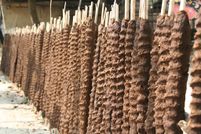Knowledge fuels change
For over a decade, Energypedia has shared free, reliable energy expertise with the world.
We’re now facing a serious funding gap.
Help keep this platform alive — your donation, big or small, truly matters!
Thank you for your support
Difference between revisions of "Cooking with Dung"
***** (***** | *****) m (→References) |
***** (***** | *****) |
||
| Line 1: | Line 1: | ||
| − | + | {{Hera}} | |
<br/> | <br/> | ||
| + | |||
= Overview = | = Overview = | ||
| Line 59: | Line 60: | ||
<br/>[[GIZ HERA Cooking Energy Compendium|--> Back to Overview GIZ HERA Cooking Energy Compendium]] | <br/>[[GIZ HERA Cooking Energy Compendium|--> Back to Overview GIZ HERA Cooking Energy Compendium]] | ||
| + | {{#set: Hera category=Cooking Energy System}} | ||
| + | |||
| + | [[Category:Cooking_Energy_Compendium_(GIZ_HERA)]] | ||
| + | [[Category:Biomass]] | ||
| + | [[Category:Improved_Cooking]] | ||
| + | [[Category:Dung]] | ||
[[Category:Cooking_Energy]] | [[Category:Cooking_Energy]] | ||
| − | |||
| − | |||
| − | |||
| − | |||
Revision as of 09:20, 27 July 2017
Cooking Energy System | Basics | Policy Advice | Planning | Designing and Implementing ICS Supply | Designing and Implementing Woodfuel Supply | Climate Change | Extra
Overview
By definition, dung is undigested waste of plant-feeding animals, meaning what is left from the plant-matter after it has been chewed up and passed through the animal´s guts. The dung of cattle, goats, sheep, yaks, elephants, llamas etc. are all popular cooking fuels, as they contain high quantities of preprocessed small-size biomass from shrubs, straw and grass
Relevance and Regional Distribution
More than 2 billion people across the planet burn dried animal dung for energy[1]. Particularly for low-income households, dung is a widely used fuel source, as it is freely available and accessible without payment. In areas where wood fuel is scarce, dung is also a commonly used fuel source. Therefore, in dry or cold areas where woody plants are not abundant, dung is a welcome concentrated pre-processed fuel (e.g. Tibet, Mongolia, high areas of the Andes, etc.). Dung is either collected in stables with domesticated animals or from pastures with free-range domesticated or wild animal herds.
Processing
Fresh dung needs to be dried before it can be used as a fuel, It is either left in in its natural shape or it is formed into round dung balls, flat dung cakes, or moulded around a stick. In some regions, dung is mixed with other kinds of fuel such as coal dust, or agricultural residues in order to enhance the burning performance by increasing the energy-density. However, due to cultural convictions, in some regions the use of dung and especially the drying of dung may not be culturally accepted.
Combustion of Dung
The organic matter content of dung ranges from 50% up to 75% depending on the moisture content, resulting in a lower heating value than wood. The heating value of dung can also vary largely between different types of dung. Studies from Aprovecho (2009) indicate values from 10000 kJ/kg to 18000 kJ/kg for cow dung[2]. However, there is no consistent and comprehensive data available for this type of fuel. In terms of carbon content, sun dried dung is low, (approximately 25%). In comparison, dried wood has a carbon content of approximately 50% and coal of approximately 70% - 90%. As a result, a high quantity of ash remains in the stove at the end of a dung-fire.
Considering that burning dung is often the only available energy source for households in some regions, this practice should be prevented wherever other suitable options are available and applicable, due to the following reasons:
- Dung is a waste product of the digestion process, but not a waste product of the agricultural production system, and has a high value as fertilizer. If dung is widely used as a fuel, the soil fertility will be affected. This change in soil fertility must be compensated with chemical fertilizer, biochar or others if long-term damages of the soil shall be avoided.
- Burning dung emits far greater quantities of dioxins and chlorophenols compared to wood[1], which are damaging to human health.
- From an energy perspective, the methanization of dung in a biogas digester is a better alternative, as cow dung contains 50% methane and 30% carbon dioxide by mass when converted into biogas[1]. However, the production of biogas on a household level is much more complex, as it involves the feasibility of location, investment costs and the availability of water.
Further Information
- Dung-burning Cookstoves, article on energypedia
- “Soil rehabilitation starts with more efficient cookstoves”by Frank Löwen (2008) describes efforts to introduce fuel saving devices such as heat exchanger, thermal insulation and stove improvements in order to lower the dung consumption for cooking and heating in Tajikistan.
- “Biomass Fuel Consumption and Dung Use as Manure”by Mekonnen, A. and Köhlin, G (2008) investigated the household energy situation, the determinants of using dung as a energy fuel instead of using it as a fertilizer in Ethiopia.
- “Emissions of Health - Damaging Pollutants from Household Stoves” by World Health Organization provides emission data on dung burning stoves
- “Indoor air pollution from burning yak dung as a household fuel in Tibet”by Xiao, Q. et al. (2014)
References
This article was originally published by GIZ HERA. It is basically based on experiences, lessons learned and information gathered by GIZ cook stove projects. You can find more information about the authors and experts of the original “GIZ HERA Cooking Energy Compendium” in the Imprint - GIZ HERA Cooking Energy Compendium.
- ↑ 1.0 1.1 1.2 Solid Biofuels http://biofuel.org.uk/solid-biofuels.html
- ↑ Witt, M. et al. (2006): Designing a Clean-Burning, High-Efficiency, Dung-Burning Stove: Lessons in cooking with cow patties. http://bioenergylists.org/stovesdoc/apro/dung/Aprodung.htm
top of page
























